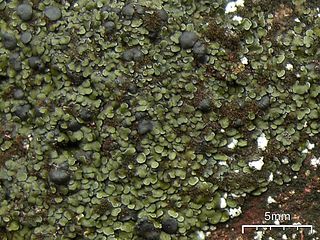
The Leotiomycetes are a class of ascomycete fungi. Many of them cause serious plant diseases.

The Sphaerophoraceae are a family of lichenized fungi in the order Lecanorales. Species of this family have a widespread distribution, especially in southern temperate regions. Sphaerophoraceae was circumscribed by mycologist Elias Magnus Fries in 1831.

Lichinales is the sole order of ascomycete fungi in the class Lichinomycetes. It contains three families: Gloeoheppiaceae, Lichinaceae, and Peltulaceae. Most species are lichenized. Lichinales was proposed in 1986 by German lichenologists Aino Henssen and Burkhard Büdel. The class Lichinomycetes was created by Valérie Reeb, François Lutzoni and Claude Roux in 2004.
The Gloeoheppiaceae are a family of ascomycete fungi in the order Lichinales. There are seven species in the family. Most species are lichenized with cyanobacteria. Species in this family are mostly found in desert areas. The family was circumscribed in 1995 by German lichenologist Aino Henssen.

The Pertusariaceae are a family of lichen-forming fungi in the order Pertusariales.

Ephebe is a genus of lichen in the family Lichinaceae.
Lichinodium is a genus of filamentous lichens. It is the only genus in the family Lichinodiaceae, itself the only member of the order Lichinodiales. Lichinodium has four species. Previously considered part of the class Lichinomycetes, molecular phylogenetic analysis revealed that Lichinodium represents a unique lineage in the Leotiomycetes—the first known group of lichen-forming fungi in this class.
Sagiolechia is a genus of lichen-forming fungi in the family Sagiolechiaceae. The genus was circumscribed by lichenologist Abramo Bartolommeo Massalongo in 1854, who assigned Sagiolechia protuberans as the type species. The family Sagiolechiaceae was proposed in 2010 to contain Sagiolechia as the type genus, and genus Rhexophiale; molecular phylogenetic analysis showed that these two genera formed a distinct clade in the Ostropales.
Leciophysma is a genus of cyanolichens in the family Pannariaceae. It has four species. The genus was circumscribed by Theodor Magnus Fries in 1865, with Leciophysma finmarkicum assigned as the type species.
Staurolemma is a genus of lichenized fungi in the family Pannariaceae. The genus was circumscribed by German lichenologist Gustav Wilhelm Körber in 1867, with Staurolemma dalmaticum as the type species.

Spilonema is a genus of lichen-forming fungi in the family Coccocarpiaceae. The genus was circumscribed by Jean-Baptiste Édouard Bornet in 1856.

Steinera is a genus of lichen-forming fungi in the family Koerberiaceae. It was circumscribed in 1906 by Austrian-Hungarian botanist Alexander Zahlbruckner. The genus was revised by Aino Henssen and Peter Wilfred James in 1982.
Hertella is a lichenized genus of fungi within the Placynthiaceae family.
Pulvinodecton is a genus of lichen-forming fungi in the family Roccellaceae. It has two species. The genus was circumscribed in 1998 by lichenologists Aino Henssen and Göran Thor, with Pulvinodecton kurzii assigned as the type species. Pulvinodecton differs from Erythrodecton in having spindle-shaped (fusiform) rather than doubly club-shaped (biclavate) ascospores, and by the development of its ascocarp. Additionally, the unusual pycnidia of Pulvinodecton species feature a deeply divided cavity with more than one ostiole.
Aino Marjatta Henssen, was a German lichenologist and systematist. Her father, Gottfried Henssen, was a folklorist and her mother was Finnish.
Austropeltum is a genus of lichenized fungi in the family Sphaerophoraceae. The genus is monotypic, containing the single species Austropeltum glareosum, found in Australia and New Zealand.
Helge Thorsten Lumbsch is a German-born lichenologist living in the United States. His research interests include the phylogeny, taxonomy, and phylogeography of lichen-forming fungi; lichen diversity; lichen chemistry and chemotaxonomy. He is the Associate Curator and Head of Cryptogams and Chair of the Department of Botany at the Field Museum of Natural History.

Roccellinastrum is a genus of lichen-forming fungi in the family Pilocarpaceae. It has seven species.
Sten Gustaf Edvard Ahlner was a Swedish lichenologist.
Lichinodium canadense is a species of minute fruticose (bushy) cyanolichen in the family Lichinodiaceae. It is found in British Columbia, Canada, where it grows on conifer bark.







